
R
E
V N
E
X
T
The complex geometries of the National Museum of Qatar seen from the outside. All photos by Ned Carter Miles for ArtAsiaPacific.
The National Museum of Qatar opened to the public on March 28 in Doha—more than two years after its original scheduled launch date in 2016. It was worth the wait. The sprawling building, designed by Jean Nouvel, renowned French architect and darling of commissions for cultural institutions in the Gulf, is itself a work of art. The monumental structure takes inspiration from the shape of a desert rose—a crystalline cluster of repetitive, interlocking discs formed from gypsum and sand, and found in a number of countries with significant desert terrain. Comprising 539 enormous discs plated with glass-reinforced concrete panels, the 52,000-square-meter building cost USD 434 million to build.
Inside the museum’s 11 galleries, exhibits were frequently accompanied by striking projections, impressively customized to fit the contours of the building’s sloping discs. Among these projections were art films produced by the Doha Film Institute in collaboration with directors including Jananne al-Ani and Mira Nair, respectively depicting the Qatari landscape and plight of the country’s pearl divers. The museum’s shop, designed by Australia-based Japanese architect Koichi Takada, is made up of 40,000 individual pieces of pre-cut, interlocking timber. Evoking a desert cave, the design contributes to the strikingly complex yet organic feel of the overall museum space.
The museum is the latest move in an architectural arms race between competing Gulf states, and follows the opening of another Nouvel-designed cultural institution in the region—the Louvre Abu Dhabi, which was unveiled in the United Arab Emirates, Qatar’s political rival, in 2017. Further illustrating rivalries in the region, on the night of the Qatar National Museum’s grand opening, Saudi Arabia, a key player in the recent Qatari diplomatic crisis, picked the moment to announce plans to transform its arts and culture sector under its recently established Ministry of Culture.
Seen in the context of tensions in the region, the museum—arguably like any national institution—is an attempt to reinforce national identity. This is represented in the permanent collections dealing with Qatar’s history, but also in the contemporary art objects commissioned for the site. Works by Ali Hassan al-Jaber and Ahmed al-Bahrani—bearing titles such as Wisdom of a Nation and even Flag of Glory (both 2019)—incorporate the colors and form of the Qatari flag, while pieces by Simone Fattal, Bouthayna al-Muftah and Hassan bin Mohammed al-Thani all reference elements of Qatari national identity and culture.
The desert rose is a highly organic form—according to Jean Nouvel, it is “the first architectural structure that nature creates.” In this regard, the museum’s supersized desert-rose exterior sits in opposition to the mechanical and jarringly arranged Doha skyline, which has been erected over barely four decades and remains in a state of near-constant flux. This fast-changing environment has been an important source of inspiration for modern and contemporary artists in the country, from so-called founder of Qatari art Jassim Zaini to younger artists gaining increasing recognition, such as Hana al-Saadi. Given that the country has relatively few contemporary artists and arts institutions—though the latter are of an often exceptional quality—and considering its current position within the Gulf region, we might ask whether this small but significantly situated display of works, paired with an impressive manifestation of architectural prestige, suggest the possibility for a move away from more analytic contemporary practices toward something prescriptive and nationalistic.
Ned Carter Miles is ArtAsiaPacific’s London desk editor.
To read more of ArtAsiaPacific’s articles, visit our Digital Library.

















